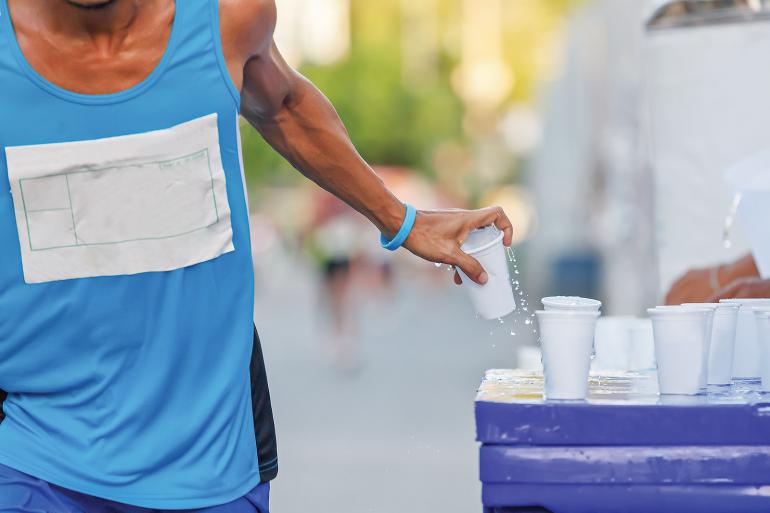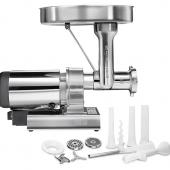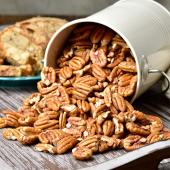Water for Thought
The physiology of sweat & electrolytes.
As a sports dietitian, I often hear from my athletes how inundated they are with hydration and nutrition information and products. They want to know how to wade through the info and find relevant applications to their own training. Some of their big questions are: how much fluid is necessary for athletes? What are electrolytes and when do we need them? And when does replenishing calories become necessary during exercise? Read on for answers to those questions, and for some baseline information on how to hydrate and fuel for future adventures.
Optimal Hydration & Sweat
Up to 60% of the human body is water. The body does a stellar job of maintaining hydration status day to day, but longer exercise bouts throw a wrench into the hydration equation. The typical amount of fluid replacement humans need throughout the day is around 3 liters for adult males and 2.2 liters for adult females. These recommendations increase with exercise, during which we lose 1-3 liters of fluid per hour.
I have found that a fluid intake of 12-30 ounces per hour during exercise applies to most endurance athletes.
We lose water through metabolism, breathing, skin, sweat, urine, and bowel movements. But during exercise, sweating is the primary way water is released from the body. Here’s a visual of the process:
Muscle contraction > heat production > increased body temp > increased blood flow to the skin > sweat production. We cool when sweat evaporates from the skin into the air.
To remain optimally hydrated, water loss must be minimized when possible, and then replaced soon thereafter. If fluids are not properly replaced after or during exercise, dehydration can occur. The main symptoms of dehydration are impaired cell function, decreased blood volume, decreased sweat rate, increased core temperature, increased glycogen use, and fatigue. These symptoms make it very hard for an athlete to perform at his or her best. To ward off dehydration, I have found that a fluid intake of 12-30 ounces per hour during exercise applies to most endurance athletes.
The Electrolytes
Sodium. Potassium. Magnesium. Calcium. Phosphate. Chloride. These six ions comprise our electrolytes. They have a natural positive or negative electrical charge when dissolved in water, and everyone needs them to survive. Magnesium and calcium are critical to muscle function, because at a cellular level they tell muscles to expand or contract. Sodium, chloride, and potassium, on the other hand, help to regulate fluid balance by recruiting the kidneys to keep the body’s amount of water and sodium in equilibrium. In addition to maintaining fluid balance, sodium plays a role in the absorption of nutrients from the gut, cognitive function, nerve-impulse transmission, and muscle contraction. When electrolytes get out of whack, severe, dehydration-like symptoms occur. About 90% of the electrolytes we lose via sweat are sodium, hence the need for sodium replacement in many situations.
Sweat Rate & Sweat Composition
When I’m developing fluid- and electrolyte-replacement strategies for athletes, there are two main factors I consider: sweat rate, and sodium concentration in sweat. The first determines the total volume of fluid lost through sweat. Sweat rate changes throughout the year, depending on heat, humidity, and fitness level, among others. The latter, also known as “sweat sodium concentration” (SSC) is the composition of one’s sweat—how much salt is lost or retained. SSC changes very little over time, as it is mostly determined by genetic factors. It is highly variable from person to person—some lose as little as 200mg of sodium per liter of sweat, all the way up to 2,000mg of sodium per liter of sweat. For context, there are 350-400mg of sodium in most electrolyte tablets. This explains why some athletes can get away with water alone during a longer effort, while others would begin to suffer with muscle cramps, fatigue, and gut issues.
Workouts that require sodium replacement do not necessarily require calorie replacement.
Consideration of both factors is vitally important in determining an athlete’s hydration needs. Luckily, there are a couple tests available which provide answers to these questions. A simple sweat-rate test can be conducted at home by weighing yourself before and after a specific length workout, and then calculating fluid loss. Alternatively, some dietitians can determine SSC with a non-exercise, non-invasive test that involves placing electrodes on the forearm to stimulate local sweat glands, and then analyzing sweat through specialized equipment.
Electrolyte vs. Calorie Replacement
Electrolyte supplements include powders, tablets, drinks, capsules, and food sources. They help to keep electrolytes (predominantly sodium) within range and often provide an energy (calorie) source as well. But remember, workouts that require sodium replacement do not necessarily require calorie replacement. I steer my athletes toward electrolyte products like Precision Hydration or Skratch Labs, which are primarily sodium with a touch of sugar to help with absorption. Workouts one hour or less rarely require sodium or calories; water is enough. For efforts of 1-2 hours, the need for sodium replacement is relevant, and often calories as well. And for workouts over 2 hours, both are mandatory.
Timing, type, and amount of hydration and fuel needed are highly individual.
Why are replacement calories needed during intense or long workouts? The body’s primary fuel source during lower-intensity activity is fat, while at higher intensities we burn mainly carbohydrates. As heart rate climbs during exercise, carbohydrates become high in demand and our precious 2-3 hours of glycogen (intra-muscular storage carbs) reserves begin to dwindle. The body pulls from its glycogen stores for as long as possible during exercise until those are exhausted and the unthinkable becomes a possibility: the dreaded “bonk” or “hitting the wall.” Hence the need to replace those lost calories lost with additional carbohydrates during exercise. There are many excellent choices available for workouts that require it—a few of my favorites are Generation Ucan, Huma Gels, and Spring Energy.
Timing, type, and amount of hydration and fuel needed are highly individual. Although determining your specific needs is an investment in time and energy, it’s well worth it to finish that next adventure feeling great and performing at your best. A sports dietitian can help you tailor a plan that fits your needs.
Brooke Schohl, MS, RD is a Registered Sports Dietitian and the owner of GRIT Sports Nutrition in Bozeman.











